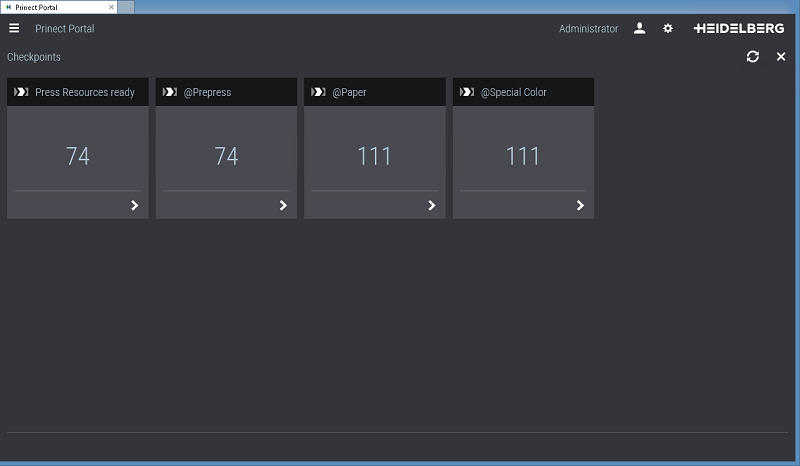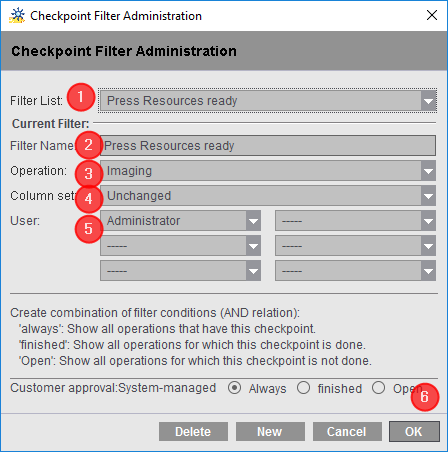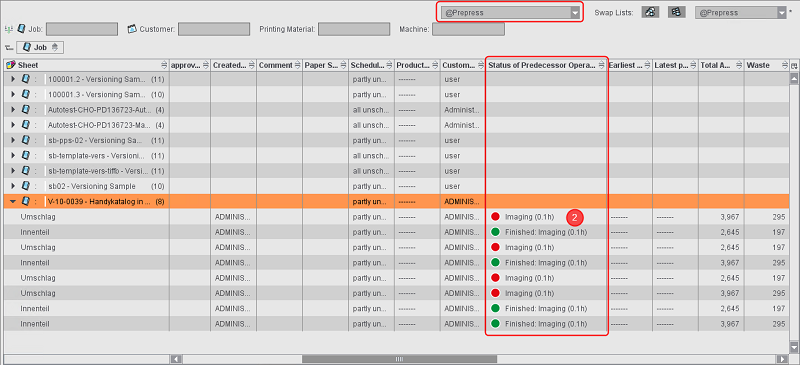
You can generate jobs in an MIS or in the Cockpit using the Planning Assistant. The operation list shows all calculated operations that can be scheduled in the Scheduler. Each operation is shown in a row of its own. Using the tools for grouping, filters and selecting columns, you can customize the view to suit your needs.

The operation list is enabled with button (1) and the job list with button (2). You can toggle between these lists at any time.
Grouping of elements:
In the operation list and job list, you can give each of the views a clearer structure by grouping elements (see Structured view).
In the operation list and job list, you can set which columns will display in which order (see Customize list view).
You can also use the context-sensitive menu to configure grouping and the columns shown for any column header.
Note: You can print the operation list to a system printer with "Print" in the context-sensitive menu. To obtain a well structured hard copy, you should generate a column scheme containing vital columns only. The width of all columns shown is scaled automatically to fit all the columns to the printer paper set in the printer driver.
|
Sheet |
Sheet name from the MIS or from Prinect Signa Station (jobs created manually). |
|
Operation |
Platemaking, precutting, printing, folding, cutting, etc. |
|
Due Date |
Finished products must be ready for dispatch. |
|
Total Amount |
Quantity (ordered quantity) + waste = total amount. |
|
Duration |
Time required by the operation. |
|
Status |
•Unscheduled not scheduled and not enabled in the planning board •Waiting Scheduled and not yet started. •Ready Can be run because all previous operations/checkpoints are finished. •Checking Checkpoint warning or alarm. •Suspended Was started and suspended. •Finished Production is finished. |
|
Setup information |
Simplex (single-sided printing), Perfecting, Work&Turn, Work&Back (work-and-tumble). •Folding Folding scheme from MIS or Prinect Signa Station: F16-6, F8-7, etc. •Saddlestitching/Perfect binding Number of sheets to be collated: 2,3,4,5,6, etc. |
|
Checkpoints |
Warnings or alerts for resource availability or production steps. |
|
Created by |
MIS creator or user who is logged in to the Cockpit. |
|
Customer Sales Representative |
Contact (CSR) |
|
Comment |
Comments from MIS or planner in the Scheduler. |
|
Paper Available on |
The paper delivery date can be sent via MIS (JMF). |
|
Checkpoints |
Warnings or alerts for resource availability or production steps. |
|
Paper Status Details |
The paper status can be sent via MIS (JMF). |
|
Earliest possible start |
Can be sent via MIS (JDF). |
|
Latest possible end |
Can be sent via MIS (JDF). |
|
Status of Predecessor Operations |
Indicates whether or not predecessor operations are finished. Show: •Red: No operations have been started •Yellow: At least one operation has been started •Green: All operations are finished |
|
Successor |
The next operation. |
|
Scheduling Status |
•All scheduled. •All unscheduled. •Unscheduled operations after total scheduling (via job changes). |
|
Article Number |
Numbers used for articles in the Packaging workflow. |
|
Good for print on the press |
Only possible with Prinect Business Manager (database status). |
|
Group Name |
Operations can be grouped in the Scheduler, and an internal group number is assigned. |
|
Location |
Each machine can be assigned to a location in the machine properties. The location entered has its own column, letting you also filter by location. |
|
Structure |
OK/with errors: Indicates whether or not operations are correctly defined in JDF. Example: Saddlestitching is an operation performed on multiple sheets and must not be sheet-specific. |
|
Production started |
Start time scheduled in the planning board. |
Note: The grouping function is an easy way to display column data in a clear structure (see Structured view).
Only active checkpoints are selectable columns
Inactive checkpoints do not display in the list of operations. You cannot activate them in the column scheme either. Changes to checkpoints (e.g. activating or deactivating checkpoints) are immediately visible after the Presettings were saved.
List of unscheduled operations after scheduling is complete
There is a column set that shows the unscheduled operations. An additional tooltip for the red figure of unscheduled operations indicates the meaning of this figure.
Checkpoints indicate overdue operations, missing approvals or resources. A traffic light system is used to indicate warnings or alerts (see "Overview, individual job" tab for an explanation of the colors).
You can define checkpoints in the "Presettings" dialog in the "Checkpoints" tab (see "Checkpoints" Tab).
Checkpoint Filter
Checkpoint filters let you show only relevant operations and hide uncritical ones. This lets you detect finished checkpoints fast.

At the top of the operation list you can set up checkpoint filtering in a list box (1) and (2). The following options are available:
•Checkpoint filter off:
There is no filtering for checkpoints.
•Prepress
Filtering for Prepress checkpoints is performed.
•Paper
Filtering for Printing Material checkpoints is performed.
•Special Color
Filtering for Special Color checkpoints is performed.
•Checkpoint Filter Administration:
The "Checkpoint Filter Administration" dialog opens (see "Checkpoint Filter Administration" dialog).
•Checkpoint Filter Web UI:
The Web UI of the Prinect Portal opens in the "Checkpoints" view. This is where you can monitor due dates.


"Checkpoint Filter Administration" dialog

You can set the following parameters in this dialog:
•All currently defined filters display in the "Filter List" (1) (no filter is defined yet in the example).
•In "Filter Name", type in the identifier for the new filter (in the example, @Prepress)
•In "Operation" (3), select the operation you wish to filter ("Imaging" in our example).
•In "Column set" (4), you can select a column scheme ("@Prepress" in our example).
•In "User" (5), you can select as many as six user accounts for which the set filter will be available.
•In the filter conditions group (6) you can set the following filter conditions:
·always:
All operations with this checkpoint display
·finished:
All operations where this checkpoint is finished display
·open:
All operations where this checkpoint is not yet finished display
When this checkpoint filter is enabled (1), you can verify the checkpoints in the "Status of Predecessor Operations" column (2).
